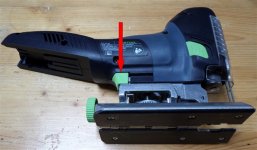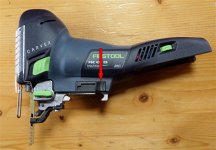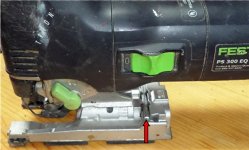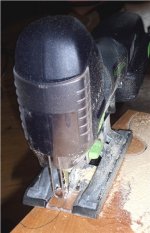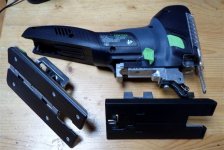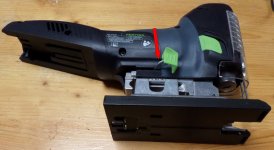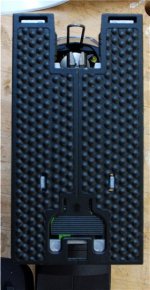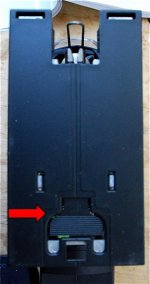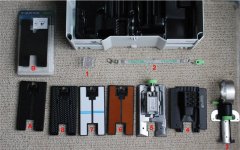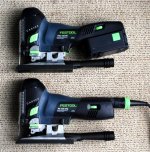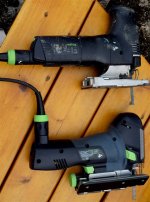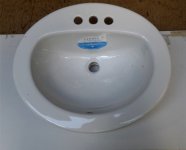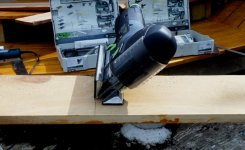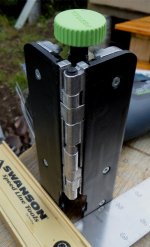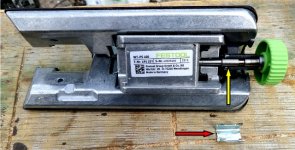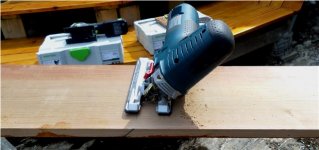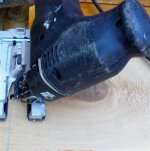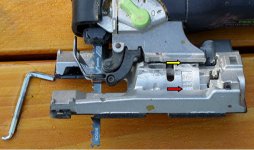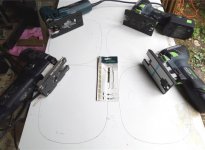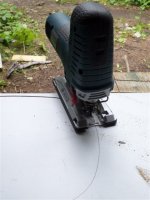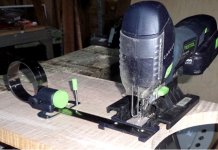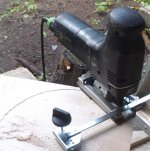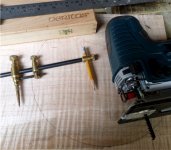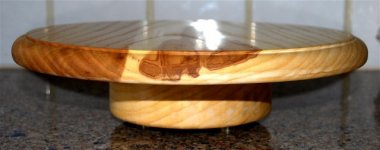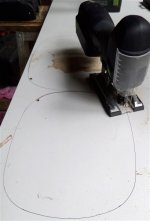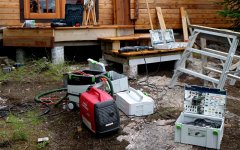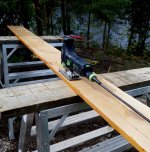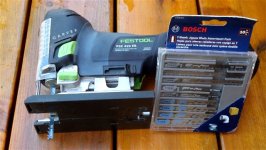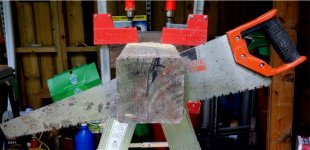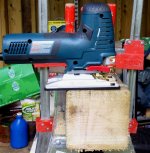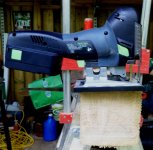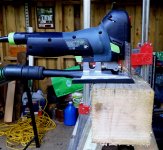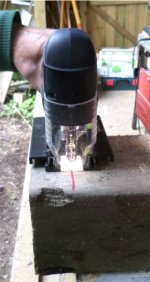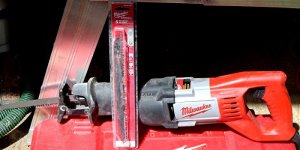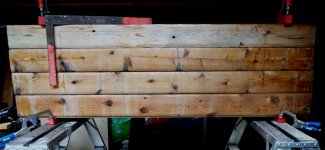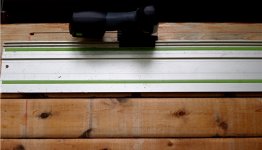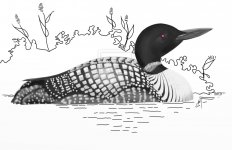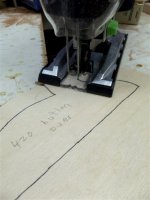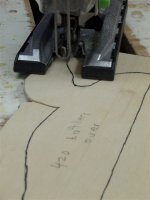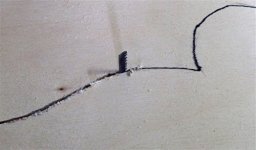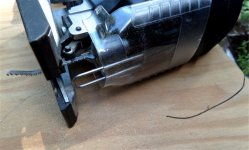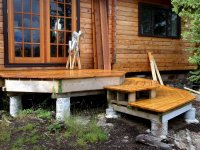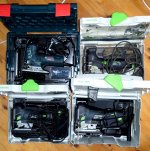(part 4 of 5)
The Tests:
The main thing that I want to determine with these test is whether a manufacturer has, at last, produced a battery powered jigsaw that I can employ as my main on-site saw. To that end I will put both the new Festool jigsaws, the older Festool Trion jigsaw, and the Bosch JS572EB jigsaw through a number of normal (for me) tasks.
[attachimg=#1]
The three Festool saws are made in Germany. The Bosch saw is made in Switzerland.
The site will be Pellow’s Island where there is no regular mains power. Thus a generator will be used for the three 120 volt electric saws.
Test 1: Cut a pressure treated spruce 6 x 6 timber into several short segments. I actually did this task seven years ago when I was building several docks and shore anchor blocks for same. The jigsaw that I used at that time was my Festool PS 2 E with a Trion S 145/4 FSG blade. By the way, Festool does not claim that this saw supports this blade well. Nevertheless, the results were acceptable for the type of accuracy required. Most of the cuts were out by a degree or two.
Six cuts were made with each of the four saws, two without the splinter guard, two with the splinter guard but no dust extraction and two with the splinter guard and dust extraction. The pendulum 3 setting was used on all saws. Speed 6 was used on the Trion and Bosch. Speed A was used on the two Carvex saws. The Bosch saw has a blower and I used it except when I had it in the four cuts where the saw was not connected to a vacuum. In all cases I guided the saw by hand following a line drawn across the timber. Bosch and Festool blades are interchangeable and the same Carvex S 145/4 FSG blade was used in the Bosch saw and the Carvex saw. A Trion S 145/4 FSG blade was used in the Trion saw. These blades are not long enough to cut all the way through the 14 cm thick timer and about 1.5 cm was left uncut at the bottom. As I had done seven years ago, I finished the cuts with a hand saw. Photos follow:
Trion without splinter guard:
[attachthumb=#2]
Completing the cut with a hand saw:
[attachthumb=#3]
Bosch without splinter guard but with blower:
[attachthumb=#4]
Carvex battery powered with chip guard only:
[attachthumb=#5]
Carvex mains powered with dust extraction:
[attachthumb=#6]
Results: -All 16 cuts were a perfect 90 degrees.
-Because it was not always easy to see the line, a few cuts wandered a little bit (at most a couple of millimetres off the line)
-The cuts using chip guards and dust extraction were perfect for all four saws. It takes some getting used to, but I managed to follow the indents and markings on the chip guards:
[attachthumb=#7]
-The blower on the Bosch did not help much, if at all.
-The lights on all three saws but the Trion did help me to see and follow the line.
-The time taken to make the cuts ranged from 22 to 27 seconds. No one saw was faster than the others. (aside: it took about an additional 30 seconds to finish up the cuts with the hand saw).
For comparison, I also cut the timber freehand with my Milwaukee reciprocating saw equipped with the best blade for the job:
[attachthumb=#8] [attachthumb=#9]
This cut took 42 seconds which is slightly less time than the jigsaw plus handsaw cuts above. The cut was acceptable but not as good as the cuts made with the jigsaws. More importantly for me, it would mean transporting an extra saw to the jobsite (which I had not done when I cut all the anchor blocks 7 years ago).
Test 2: Cut an opening in a log wall. Again, this is a task that I have done. Two years ago I cut an opening in the log wall on the one side of my cabin in order to replace a window with French doors. The “logs” are milled western red cedar and are 2.5 inches thick. I used a guide rail and a Festool circular saw to make the horizontal cuts required. Festool frowns upon this operation and I admit that it was a task that I approach with some trepidation and with great care. Here is one photo taken at the time:
[attachthumb=#10]
There is no doubt that making the cuts with a jig saw is an easier operation, and one that Festool would approve of.
I kept the logs that I cut out and used them to simulate a complete wall. The red lines show where the opening will be cut:
[attachthumb=#11]
Guide rail adapters exist for all four jigsaws but I don’t have them for the Bosch or the Trion. So this test was only done with the two Carvex saws.
The distance between the Carvex S 145/4 FSG blade and the guide rail is 34 millimetres, therefore I positioned the edge of the guide rail that distance below the red line. I used first the battery-powered Carvex:
[attachthumb=#12]
then the mains-powered Carvex to make the cut. Again, I used pendulum setting 3 and speed A. Dust control was not used. Both saws cut at the same speed (about 30 centimetres a minute). Both saws made a perfect cut. I felt more comfortable using a jig saw this way than I felt with a circular saw. It was slightly easier to use the battery powered saw because of the lack of a power cord. The power cord was not a big problem, just a slight annoyance –but I think that the hose would have been much more in the way had I chosen to utilize dust collection.
Test 3: Use a fine scrolling blade (S 50/1.4) to cut out an outline of this loon
[attachthumb=#13]
out of 6mm thick Baltic birch plywood. My granddaughter, Isla, plans to paint the cut-outs for an art project of some type. Since I am doing these tests at a lake in Northern Ontario that has many resident loons, this is a very appropriate project.
I prefer to do such cuts with the jigsaw under the panel being cut but I understand that this is not the preferred method for most North American folks; therefore, I will use both the ‘below panel’ and ‘above panel’ methods.
As is obvious in the photo below, when cutting a pattern this precise, the pointer on the splinter-guard cannot be used to following the line:
[attachthumb=#14]
In fact, I found that, for all four saws, it is easier to follow the line if no splinter-guard is used and the light is turned off. I did have good task lighting. If I hadn’t, I would have made do with the lights built in to three of the four saws. Below, the battery-powered Carvex 420 is being used in what I found to be the best above panel setup.
[attachthumb=#15]
It is possible to set the light on the Carvex to one of three modes, that is to: (1) strobe, (2) continuous, or (3) off. The method used to set the mode is more complicated than I think is necessary. The Bosch saw also has a light but the light is limited to ON and OFF settings. Of course, setting to Bosch light ON or OFF is much more straightforward.
In this photo:
[attachthumb=#16]
the saw is underneath the panel being cut leaving only a portion of the blade above the panel.
I managed to get good loon cut-outs with all four saws. Using the saws both above and below the panel, there was really no difference in the quality of the eight loons. All cuts were done with the saws at half speed. Dust did not get in the way of seeing the blade when sawing above the panel, so I did not need to use either the dimpled base on the Carvex saws nor the blower on the Bosch saw. It was definitely easier and faster making to cuts with the saws under the panel. Both above and below the panel, I found it easier to manipulate the cordless saw.
I do have one warning. When cutting with the saw below the panel, I find the S 50/1.4 blade to be shorter than I would like. When fully retracted, the blade extends only 6 mm above the base and I, when using the under the panel method with this blade, I don’t like to cut material any thicker than 1 centimetre. This photo:
[attachthumb=#17]
shows how I bent a blade when cutting a pattern in 22 mm material. This happened because I relaxed the pressure on the saw a little bit thus letting the end of the blade hit the underside of the material.
Festool claims that this blade can be used to cut material up to 30 mm and I find this to be true when the saw is positioned above the material that is being cut.
Test 4: I need to install cedar facing boards in order to hide the under-structure on this porch and steps:
[attachthumb=#18]
This task involves both regular and 45 degree crosscuts at well as ripping of the eight 1x8 (really ¾ inch by 7½ inch) partly stained cedar boards that are leaning against the wall. I do have a Festool circular saw and rails with me at the island and would normally use these to do the ripping but for the purposes of this test, I will do all the cutting with the jigsaws. I can justify this because I often do ripping with a jigsaw on jobs where I have not hauled along a circular saw.
I used all four saws for all three types of cuts. All the work was done with a Bosch 144D wood speed blade.
[attachthumb=#19]
In the assumption that a rail is not available at this job site, the ripping was done following a pencil line. In the photo below, the Trion is being used for this task:
[attachthumb=#20]
All four saws did an equally good job. After each cut, I spent about a minute smoothing out the cuts with a Festool Rotex 90 sander and the resulting edges were more than good enough for this project.
Here is a photo of the job site after the work was well underway:
[attachthumb=#21]
The real differences among the saws showed up when doing 45 degree cross-cuts. First up was the Trion:
[attachthumb=#22] [attachthumb=#23]
Angles are set on the Trion by first releasing the base with the attached Allen key rotating the base in order to align the edge pointed to by the yellow arrow to the scale pointed to by the orange arrow. It is difficult to achieve an accurate angle using this mechanism. It is particularly hard to cut a 45 degree angle because the edge hides the scale. In this case, the angle that I set turned out to be about 43.5 degrees and this was good enough for the job. It was quite easy to follow the line using the Trion.
Setting a 45 degree angle on the Bosch proved to be a simple matter of opening a lever, setting the base to a positive 45 degree stop, then re-setting the lever. However, following the line was not easy because it was somewhat obscured by the base:
[attachthumb=#24]
During the job, I made five cross-cuts with the Bosch and all cuts were bang on to 45 degrees. But, every time, I jogged off the line a bit somewhere in the cut. No deviations were serious enough to prevent using the cut board on the job.
On the Carvex saws, such angles are cut using the special angle base. Changing to this base is fast and easy but setting the angle is more fiddly than I expected it to be. There are no positive stops so the angle must be set using a square.
I was very surprised when a part fell off the base:
[attachthumb=#25] [attachthumb=#26]
The part easily snapped back on, but now I will always have to take special care not to lose it.
It is almost, but not quite, as easy to follow to line with the Carvex saws set to an angle as it is with the the Trion.
[attachthumb=#27]
All the angled cross-cuts that I made with both Carvex saws were perfect.
Several standard cross-cuts were also made with all four saws. All cuts were good and my only preference was not having to turn on the generator first when using the battery-powered Carvex.
Interestingly, I observed is that my go-to saw when needing to make some quick cuts to the underlying timbers was the battery-powered Carvex equipped with an S145/4 FSG blade:
[attachthumb=#28]
Test 5: I am building a wash-stand here at camp. The top will be cut out of material re-cycled from the counter-tops that I recently replaced in out kitchen in Toronto. A cut-out will be made for this sink:
[attachthumb=#29]
I didn’t have sufficient extra countertop material to make four full size sink-cut-outs, but I did have enough to cut out these four smaller ovals:
[attachthumb=#30]
A Festool S 75/4 K fast scrolling blade was used in all four saws. I used a chip guard but no dust control. The pendulum 3 setting was used on all saws. Speed 6 was used on the Trion and Bosch. Speed A was used on the two Carvex saws. Here are photos of the Bosch and the battery-powered Carvex performing this task:
[attachthumb=#31] [attachthumb=#32]
All of the saws did an excellent job in about the same amount of time. No one saw was any better than the others at this task. I tried both the Hard Fibre base and the Steel base on the Carvex saws and noticed no difference as compared to the Standard base.
Test 6: I have made many “Lazy Susan” turntables in the past out of various types of figured hardwoods. Here is one that I recently made out of ash:
[attachthumb=#33] [attachthumb=#34]
They make great gifts. I like to keep three or four on hand for that purpose. But, right now, I have none.
I have a small supply of figured maple here on at Pellow’s Camp, therefore decided to cut some disks with the jig saws. In the past, I cut all the turntable disks using tools other than jig saws, that is: band saw, router, and even table saw.
I have both the Carvex and Trion circle jigs. Bosch makes circle jig for my saw, but I don’t have it.
The same blade and saw settings were used in this test as in Test 5.
With the Bosch, I first marked the circle with a compass and then cut it following the outside of the line. I made use of both the blower and the light.
[attachthumb=#35] [attachthumb=#36]
The resulting disk is not perfect but it is acceptable and can easily be cleaned up with a router.
With the use of the circle jig:
[attachthumb=#37]
the disk cut with the Trion was perfect. There is no scale on the jig and I found it tedious to set up. Once set up, it took about half the time to cut the disk with the Trion as compared to the Bosch.
The circle jig on the Carvex fits into the same base as the one used with the rail (see Test 2 above), it is easy to set up and has a built-in scale. Here are photos of the jig in use, first with the battery-powered Carvex and then with the mains-powered Carvex:
[attachthumb=#38] [attachthumb=#39]
The scale on the jig was accurate to the millimetre and both the resulting disks were perfect. It took me slightly less time to cut the disks with this jig than it took with the Trion jig.
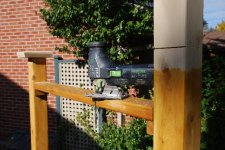 Arbour 27 -Cutting the tops off the posts with a jig saw -small.JPG122.8 KB · Views: 1,407
Arbour 27 -Cutting the tops off the posts with a jig saw -small.JPG122.8 KB · Views: 1,407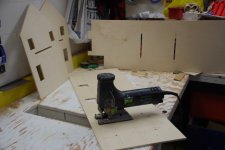 Doll house 01-cutting parts with jig saw -small.JPG83 KB · Views: 1,244
Doll house 01-cutting parts with jig saw -small.JPG83 KB · Views: 1,244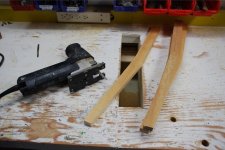 Chairs and table for Jamie 04 -Cutting the back pieces of the chair frame using a jig saw -small.JPG107.2 KB · Views: 1,437
Chairs and table for Jamie 04 -Cutting the back pieces of the chair frame using a jig saw -small.JPG107.2 KB · Views: 1,437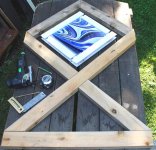 Tools used to cut gate support frame -small.JPG218.1 KB · Views: 1,567
Tools used to cut gate support frame -small.JPG218.1 KB · Views: 1,567 Frank Pellow on Lake Pivabiska.JPG276.6 KB · Views: 1,067
Frank Pellow on Lake Pivabiska.JPG276.6 KB · Views: 1,067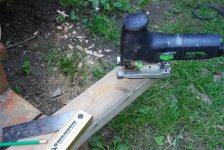 My typical use of jigsaw to cut framing material -small.JPG164.6 KB · Views: 1,191
My typical use of jigsaw to cut framing material -small.JPG164.6 KB · Views: 1,191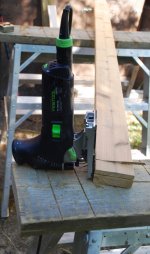 Cutting a rabbet in a board using a very long jigsaw blade -small.jpg381.7 KB · Views: 1,556
Cutting a rabbet in a board using a very long jigsaw blade -small.jpg381.7 KB · Views: 1,556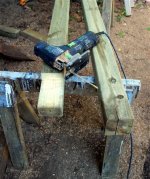 Wood Shed 07 -Cutting notches with a very long jig saw blade -small.JPG104.9 KB · Views: 1,511
Wood Shed 07 -Cutting notches with a very long jig saw blade -small.JPG104.9 KB · Views: 1,511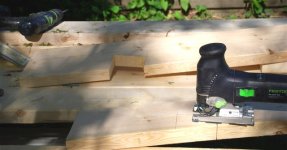 New Shed for Kathleen 18 -Cutting notches in rafters with jigsaw -small.JPG76.2 KB · Views: 1,541
New Shed for Kathleen 18 -Cutting notches in rafters with jigsaw -small.JPG76.2 KB · Views: 1,541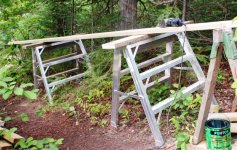 Cutting 2x6s for dock with jig saw -small.jpg213.7 KB · Views: 1,480
Cutting 2x6s for dock with jig saw -small.jpg213.7 KB · Views: 1,480
